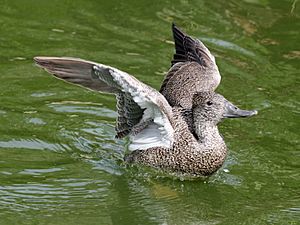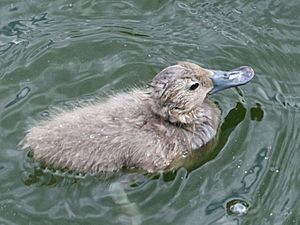Freckled duck facts for kids
Quick facts for kids Freckled duck |
|
|---|---|
 |
|
| Male | |
 |
|
| Female | |
| Conservation status | |
| Scientific classification | |
| Genus: |
Stictonetta
|
| Species: |
naevosa
|
The freckled duck (Stictonetta naevosa) is a special type of water bird that lives only in Australia. People sometimes call it the monkey duck or oatmeal duck. These ducks usually live in inland Australia. But when it gets dry, they move to wet areas near the coast. During these dry times, many freckled ducks gather in large groups. This can make them seem more common than they actually are.
The number of freckled ducks is at risk. This is because their homes are being destroyed. Also, droughts and hunting can reduce their numbers. When their homes are lost or there's a drought, the ducks might move to coastal areas. Here, people might not know they are a protected species, which can lead to more hunting.
In recent years, several places have started programs to help freckled ducks breed. These include the Hunter Wetlands Australia, Slimbridge Wetlands, Melbourne Zoo, Bronx Zoo, Adelaide Zoo, Healesville Sanctuary, and Tidbinbilla Nature Reserve. Some of these programs have been successful in helping the ducks.
Contents
What the Freckled Duck Looks Like
The freckled duck has a very unique look. Adult ducks have dark grey to black feathers with small white spots. These spots make them look "freckled." Their feet, legs, and bill are all a slate grey color.
Baby ducks (hatchlings) and young ducks (juveniles) are light grey all over. They keep these feathers until they are about 32 weeks old. Then, they grow their adult "freckled" feathers.
Adult male and female freckled ducks have a few differences. Males are usually bigger. They weigh between 700 and 1200 grams. Females weigh a bit less, from 600 to 1200 grams. Both sexes are about 50 to 60 centimeters long.
During the breeding season, males get a red color at the base of their bill. Males that are ready to breed have a deep red color. Other males might have lighter red, or no color at all. A deep red bill also shows that a male is strong and likely to breed with females.
Where Freckled Ducks Live and Their Homes
Freckled ducks live only in Australia. They are mostly found in the inland parts of eastern Australia. This includes New South Wales, Victoria, and Queensland. They also live in South Australia and Western Australia.
Where freckled ducks live depends on how much water is in rivers and wetlands. Because of this, large groups of these ducks are found in places like the Paroo-Warrego catchment and Lake Torquinie. Many have also been seen in the Cooper's Creek area and Lake Gregory.
Freckled ducks need different types of homes for breeding and non-breeding times. They don't seem to migrate (travel long distances) in a regular way. But they do travel far to find good breeding spots. They prefer large, fresh water areas with lots of plants. These are often recently flooded wetlands and swamps.
After breeding, they move to more open coastal areas. These places have permanent water bodies like lakes, reservoirs, and ponds. These areas usually have fewer plants.
How Freckled Ducks Live
What Freckled Ducks Eat
What freckled ducks eat has been a topic of discussion. This is because their diet can change depending on where they live. However, it's generally agreed that freckled ducks are good at finding food. They are "filter feeders," meaning they strain tiny food particles from the water. They eat many things like water plants, insects, algae, larvae, and small crustaceans. Studies show they like to feed in shallow water. They use their bill to strain food from mud or sand.
Social Life of Freckled Ducks
Freckled ducks are very social birds. They often live in flocks of 10 to 100 ducks, especially when it's not breeding season. During breeding season, these large flocks often break into smaller groups. These smaller groups spread out in wetlands and swamps.
Even in large flocks, freckled ducks don't show much emotion or interact a lot with each other. When they do interact, it's often a small disagreement.
Bathing Habits
Not much research has been done on how freckled ducks bathe. But it's known that water is very important for them. They need water for feeding, mating, and bathing. Freckled ducks have been seen cleaning their feathers both in the water and after they come out. They don't seem to need dust or other materials for bathing.
Reproduction and Life Cycle
Freckled ducks are a polygamous species, meaning one male can mate with several females. However, they form short-term pairs during the breeding season. In these short pairings, the male protects the female before she lays eggs. The male also helps build and protect the nest. But he leaves before the female lays her eggs. He does not help raise or protect the young.
Freckled ducks have simple behaviors before and after mating. Mating happens in the water. The male approaches the female, who gets into a special position. The male then gets on the female's back and holds her neck feathers. After mating, both ducks clean their feathers.
The breeding season for freckled ducks is usually from September to December. But they can also breed at other times. Breeding outside this season often happens after heavy rainfall and floods.
Both male and female freckled ducks can start breeding when they are about 12 months old. They can continue to breed every year throughout their lives. Some ducks have successfully bred when they were over 10 years old.
Freckled duck eggs usually hatch after 26 to 28 days. Some sources say it can take up to 35 days. The female duck is the only one who sits on the eggs. She only leaves them for short times to eat.
A female usually lays about seven eggs, but it can be anywhere from four to 14 eggs. Sometimes, a female will lay her eggs in another female's nest. This is called "egg dumping." It allows the female to pass on her genes without using energy to raise the babies herself.
Freckled duck eggs are shiny, smooth, and almost perfectly oval. They are white, from cream to ivory in color. Their eggshells are unique because they are very thick but soft. The eggs are usually 60-65mm long and 45-48mm wide, weighing about 66 grams.
Baby freckled ducks (hatchlings) are "precocial." This means they are born ready to move and feed themselves. But they still need their mother to survive. Besides protection, the mother teaches them important social behaviors.
The ducklings learn to fly later than other water birds, at nine weeks old. By this time, they no longer need their mother's protection. Then, the mother and her young often rejoin a larger flock.
Freckled Ducks in Zoos and Sanctuaries
In the past, keeping freckled ducks in captivity was hard. There were problems with stress, breeding, and many chicks not surviving. But in recent years, places like the Hunter Wetlands Australia and Slimbridge Wetlands UK have had success. They have managed to breed chicks that survive to adulthood.
Freckled ducks get along well with other ducks. They can be kept in groups of different sizes and with other species without fighting. However, breeding programs have not been as successful when they are housed with other types of birds.
One important thing to consider when keeping freckled ducks in captivity is "imprinting." Imprinting is when a young animal learns to recognize its parent (or another animal, person, or thing) very early in life. If baby ducks imprint on human keepers, it can be a problem. This is because they need their mother to learn important behaviors like how to make sounds and find food.
Protecting the Freckled Duck
The freckled duck is currently listed as "Least Concern" by the IUCN. This means they are not in immediate danger of disappearing. Their population numbers go up and down quite a lot. In 2016, there were an estimated 7,300 to 17,000 adult ducks.
One threat is that hunters sometimes mistake them for other game birds and shoot them. Another big threat is the destruction of their swamp homes. This happens because of projects that change water flow. This could cause the duck population to drop by up to 20% in the next 15 years.
Images for kids
See also
 In Spanish: Pato Pecoso para niños
In Spanish: Pato Pecoso para niños










